



Born in 1947, Michael Wm. Kaluta is only the third illustrator I've profiled who is younger than I. He's the only one of these 100 who has actually been to my home. He's also a hell of a nice guy and a tremendous artist. He was born in Guatemala and spent his childhood on a series of Air Force bases, mainly in the eastern U.S.
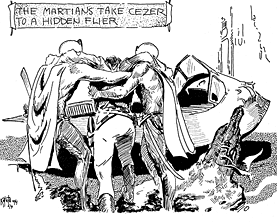 He
was influenced early in his teens by Roy
Krenkel and Frank
Frazetta. Their work on the Ace reissues of Edgar Rice Burroughs
novels, as well as the novels themselves, instilled him with a
fascination with fantasy that is evident in everything he draws.
Some of Kaluta's earliest published work was for Graphic Showcase,
a fan magazine in 1967. Titled Eyes of Mars, it
was an obvious tribute to John Carter, Burroughs' famous Martian
adventurer.
He
was influenced early in his teens by Roy
Krenkel and Frank
Frazetta. Their work on the Ace reissues of Edgar Rice Burroughs
novels, as well as the novels themselves, instilled him with a
fascination with fantasy that is evident in everything he draws.
Some of Kaluta's earliest published work was for Graphic Showcase,
a fan magazine in 1967. Titled Eyes of Mars, it
was an obvious tribute to John Carter, Burroughs' famous Martian
adventurer.
Back in the 1960's, comics fans published dozens, if not hundreds, of fanzines. Young artists who might have been drawing comic books in a more open market were relegated to learning their craft in the pages of these zines. Every subculture has its own hierarchy, and the world of fanzines and fanzine artists was no different. The "best" of them were printed via photo offset and had circulations into the 2000 to 3000 range. Some of these were the "artzines" and their editors strove to get contributions from the likes of Jeffrey Jones, Bernie Wrightson, and Michael Wm. Kaluta.
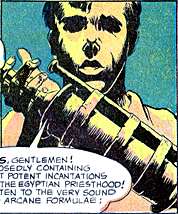 The
three young "Turks" of comics fandom met at a convention
in 1967. The next year the comic book market opened its doors
to newcomers for the first time in 15 years. In 1969, Kaluta was
given his first professional assignment. It was for Charlton,
a second string comics publisher. He even had some rudimentary
strips in 1969 issues of that bastion of hippie counter-culture,
The Gothic Blimp Works. But it wasn't long before he was
doing short stories for DC comics - one of the top two comic book
companies. At right is a panel from a 1970 story in House of
Secrets.
The
three young "Turks" of comics fandom met at a convention
in 1967. The next year the comic book market opened its doors
to newcomers for the first time in 15 years. In 1969, Kaluta was
given his first professional assignment. It was for Charlton,
a second string comics publisher. He even had some rudimentary
strips in 1969 issues of that bastion of hippie counter-culture,
The Gothic Blimp Works. But it wasn't long before he was
doing short stories for DC comics - one of the top two comic book
companies. At right is a panel from a 1970 story in House of
Secrets.

|
| Carson of Venus |
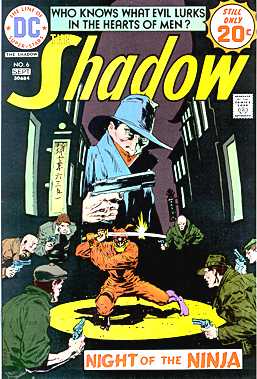 Michael
quickly moved up in the ranks of the new crop of comic book artists.
By 1972 he was illustrating the adventures of Carson Napier, better
known to Edgar Rice Burroughs aficionados as Carson of Venus.
The next year he began his signature run on The Shadow,
also for DC comics.
Michael
quickly moved up in the ranks of the new crop of comic book artists.
By 1972 he was illustrating the adventures of Carson Napier, better
known to Edgar Rice Burroughs aficionados as Carson of Venus.
The next year he began his signature run on The Shadow,
also for DC comics.
The Shadow was a pulp and radio character from the 1930's and 1940's. He was famous for his eerie laugh, his ability to "cloud the minds" of mere mortals and for the question, "Who knows what evil lurks in the hearts of men?" Kaluta's treatment was both eerie and sinister and it was during this short run of five issues and a couple of covers that the first inklings of his mature style would surface.
Just how low will a struggling young artist stoop to keep the wolf from the door? Take a look at this 1973 record album cover - one of the very few Michael has done in his career. (He also did "Lenny White presents The Adventures of the Astro Pirates" in 1978.)
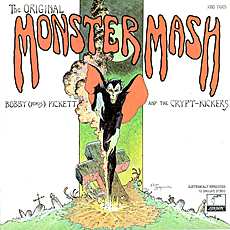
The lingering echoes of the old pulp magazines were the science fiction digests like Amazing and Fantastic. For many artists of the era, they provided an outlet for pen or brush and ink drawings that were quickly done. The occasional color cover showcased Michael's developing style in the early 1970's.
He honed that style in the mid-seventies as he explored the then-burgeoning market for limited prints and portfolios.One of his earliest attempts at painting was for Christopher Enterprises' 1975 Dante's Inferno Portfolio. Of the eight plates, two showed a direction that Kaluta would follow and eventually claim as his own. Loosely symmetrical and featuring sensuous Art Nouveau curvilinear swirls, this combination of composition and earthiness would become his trademark.
| Plates 4 & 5 from Dante's Inferno | |
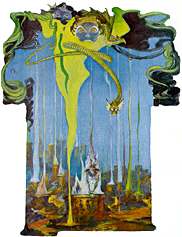
|
 |
| Dis, Styx, and Dame Fortune | Furies and Tombs of the Heretics |
Other outlets beyond the limited comic book venue were the illustrated books that were making a minor resurgence, especially illustrated editions of Robert E. Howard stories. The Lost Valley of Iskander and The Swords of Shahrazar were two of Kaluta's entries into this growing market in 1974 and 1975. He also painted the dust jacket for The Shudder Pulps in 1975. He even teamed with his childhood idol, Roy Krenkel, on illustrations for a 1975 DAW paperback by Lin Carter, As The Green Star Rises, which must have been a thrill.

 In 1976, he
rented a studio in New York City with Jones, Wrightson, and a
young English comic book artist named Barry Smith. Barry would
quickly add the upper class "Windsor" to his name and
has been known ever since as Barry Windsor-Smith. The impact of
The Studio on each of these artists has been debated for decades.
It only lasted for four years and produced, in 1979, a documentary
record in the form of a book called simply The Studio.
Michael's work and style solidified during this time. With a print
market ready to gobble up whatever he could produce, he was left
to his own devices to develop his work discipline and his drawing
and painting skills.
In 1976, he
rented a studio in New York City with Jones, Wrightson, and a
young English comic book artist named Barry Smith. Barry would
quickly add the upper class "Windsor" to his name and
has been known ever since as Barry Windsor-Smith. The impact of
The Studio on each of these artists has been debated for decades.
It only lasted for four years and produced, in 1979, a documentary
record in the form of a book called simply The Studio.
Michael's work and style solidified during this time. With a print
market ready to gobble up whatever he could produce, he was left
to his own devices to develop his work discipline and his drawing
and painting skills.
Elegant, romantic and exotic compositions were pulled from his mind as he struggled to limn the images he could conceive there. Like "Solo" at left, from 1977, the concept begs for clarification while the composition leads our eyes to every carefully-rendered detail. Other enigmatic Studio-era prints were "Why he doesn't sleep at night," "She's leaving home," "Behind Neptune's throne," "Icarus had a sister," and the fascinating "Intolerance," at right, issued only as a photoprint in an edition of 100.
In 1978, Kaluta was one of artists profiled in Dream Makers, a Paper Tiger book devoted to the working space and styles of six fantasy artists. The photo below, taken from that book, of Michael at work in his New York apartment speaks volumes.
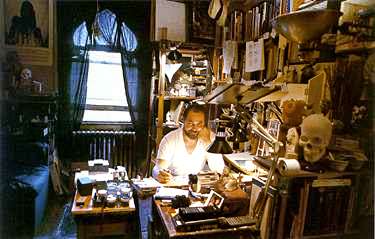
 |
| Seven Sisters |
For a time, circular elements dominated his compositions. All four plates in his 1979 Children of the Twilight Portfolio were structured around a circle motif (see Seven Sisters above), as were the pen and ink plates for his 1984 Bird of Death Portfolio. He eventually expanded beyond the circle, but his work maintains a precisely composed feel that anchors each image solidly so that we can examine all of the intricate detail at our leisure without losing our grounding.

|
| Starstruck, "The Luckless, the Abandoned and Forsaked" |
Fortunately for us, the elfin side of him, that Puck-ish humor that was getting lost in the intolerance of twilight deaths, was rescued by his meeting with playwright Elaine Lee. Together they crafted Starstruck, an exotic, erotic, obtuse and wildly humorous sf space opera, first produced as a play in 1980 and again in 1983. Populated mainly by increasingly intriguing females like Brucilla, Galatia 9 and Erotica Ann, it appeared in glorious comic form in Heavy Metal Magazine starting with the November 1982 issue. Kaluta placed Lee's outrageous and improbable characters in rollicking, wild and violent worlds that were impossible to create on the stage. Starstruck quickly took on a new life as a comic book.
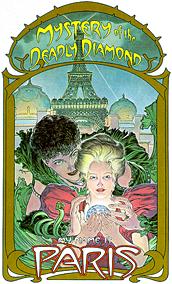
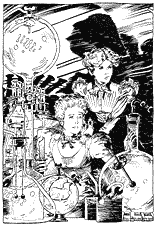 To
my mind, the mature Kaluta style debuts in a 1987 series of novels
for teenage girls. There were four titles in the My Name
is Paris series and they took place at the turn of the
20th century. Taking inspiration from the Art Nouveau movement
of the time, Michael combined the composition, the symmetry, the
circles and the sensuous line of his pen into a cohesive approach
that would serve as his artistic approach for decades. At left
is the cover for the fourth in the series, The Mystery of the
Deadly Diamond. Each title also contained four black &
white plates (see sample at right).
To
my mind, the mature Kaluta style debuts in a 1987 series of novels
for teenage girls. There were four titles in the My Name
is Paris series and they took place at the turn of the
20th century. Taking inspiration from the Art Nouveau movement
of the time, Michael combined the composition, the symmetry, the
circles and the sensuous line of his pen into a cohesive approach
that would serve as his artistic approach for decades. At left
is the cover for the fourth in the series, The Mystery of the
Deadly Diamond. Each title also contained four black &
white plates (see sample at right).
His comic work in the Eighties was primarily covers, though he did pencil a Shadow graphic novel in 1988. While Hitler's Astrologer is an excellent job, the inks by comic book great Russ Heath took some of the tension out of Kaluta's lines and resulted in a great comic story but a less than satisfying Kaluta one.
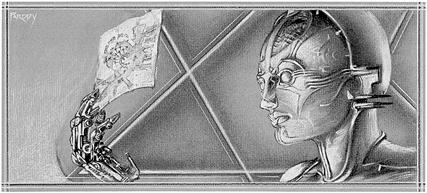
When looking for Kaluta's masterpiece, high consideration must be given to the amazing 1988 illustrated edition of Thea von Harbou's Metropolis. Not a comic adaptation, but a true illustrated book in the classic sense, this has color and duotone plates, plus chapter headings (see above) and striking dust wrapper and endpaper illustrations. Fusing his Art Nouveau line with an Art Deco design that befit the project, Metropolis was written by the wife of Fritz Lang who realized the vision on the silent screen in 1927. Kaluta's reinterpretation is faithful to both the heart of the screenplay and the spirit of the film.
Other projects fleshed out the decade: new Starstruck projects for comics, a graphic adaptation of the film, The Abyss, and illustrations for a couple of book projects. Like many a facile artist, Kaluta found himself drawn into visualizing film properties and characters for animation and computer games. Many of these projects would never come to fruition and exist only in his copious notebooks. Echoes, The Drawings of Michael William Kaluta was published in 2007 by J. David Spurlock of Vanguard Publishing.
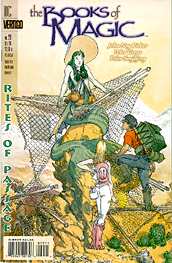
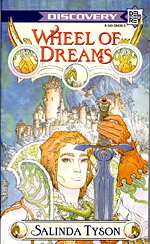 The nineteen
nineties brought one of the more bizarre teamups on a series of
Harry Harrison collaborations for his Bill the Galactic Hero character.
While each of the four 1991 books featured a 16-page insert section
of nice Kaluta pen drawings, the covers were Steve Fastner airbrush
renditions of drawings that displayed fewer Kaluta characteristics
than Hitler's Astrologer. Weird. Another little-known Kaluta
image is the 1996 Del Rey paperback, The Wheel of Dreams.
His 12 paintings for the 1994 J.R.R. Tolkien Calendar are
classics and make that year one of the most sought after of the
long series. He did lots more comic book covers, including a long
run on DC/Vertigo's The Books of Magic from 1996 on and
a superb series on The Spectre, also from DC.
The nineteen
nineties brought one of the more bizarre teamups on a series of
Harry Harrison collaborations for his Bill the Galactic Hero character.
While each of the four 1991 books featured a 16-page insert section
of nice Kaluta pen drawings, the covers were Steve Fastner airbrush
renditions of drawings that displayed fewer Kaluta characteristics
than Hitler's Astrologer. Weird. Another little-known Kaluta
image is the 1996 Del Rey paperback, The Wheel of Dreams.
His 12 paintings for the 1994 J.R.R. Tolkien Calendar are
classics and make that year one of the most sought after of the
long series. He did lots more comic book covers, including a long
run on DC/Vertigo's The Books of Magic from 1996 on and
a superb series on The Spectre, also from DC.
Edgar Rice Burroughs' siren call was heard once more in 1998 as Michael was chosen to provide illustrations for the last unpublished ERB story, Minidoka.
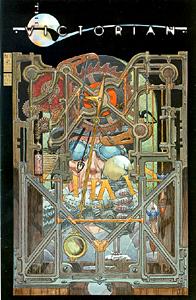
In 2001, his cover for issue #8 of The Victorian comic book received the Spectrum Silver Award in the comics category. He just keeps getting better and better. He's a fitting capstone to my biographical efforts on this web site. My hat's off to you, Michael. I'm looking forward to whatever you do next.
A quick update: in February of 2003, Michael received the Grand Master Award at the Spectrum judging. Congratulations!
 To learn more about Michael Kaluta, see:
To learn more about Michael Kaluta, see:| The Dream Makers | Paper Tiger, 1978 |
| The Studio | Dragon's Dream, 1979 |
| Echoes, The Drawings of Michael William Kaluta | Paul Chadwick & M.W. Kaluta, Vanguard 2000 |
| The Vadeboncoeur Collection of Knowledge | Jim Vadeboncoeur, Jr. 2001 |
|
Illustrations are copyright by their
respective owners. This page written, designed & © 2001 by Jim Vadeboncoeur, Jr. Updated 2003, 2011. |
